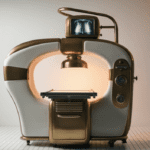Technical advances such as virtual reality are making inroads into medicine, including imaging. These advances will have a big impact on patient compliance and satisfaction while proving to be a tool to ensure optimal quality images.
According to an article published on August 12 by AuntMinnie.com patients wearing virtual reality goggles during their MRI scan may go a long way in reducing claustrophobia and anxiety, resulting in increased scan quality and patient satisfaction.
To relieve anxiety MRI Imagers have developed educational material, videos, or even mock exams. Music also is a tool to help the patient relax while in the scanner. While these tactics sometimes work, many patients are still uncomfortable, and sedation or anesthesia is needed to complete the exam. With the advances in virtual reality, the need for medication may also be reduced.
The virtual reality headset is attached to a standard MRI head coil that is “light-tight” so patients can’t see their surroundings. The headset is made of plastic, except for two MRI-compatible cameras, one for each eye; the headset is controlled by the patient’s gaze.
The virtual reality headset prototype can immediately project content on an MRI-compatible screen beyond the head coil on the imaging table; in fact, it can begin doing this before the patient is in the scanner so that he or she doesn’t see the MRI system at all.
As patients are being placed in the scanner, they are presented with a scene in which they are lying face up; their eye-tracking is calibrated to the headset. Then the scene changes to simulate an upright position and the patient can choose content such as films or games as well as access a link that will connect them to the staff person performing the exam.
According to a study published on August 11 in Scientific Reports, one study participant helped the team calibrate the headset and 13 more participants tested the calibration. An additional 22 more study participants, six of whom were children between the ages of seven and 11, were asked to run through the virtual content and test the feasibility of gaze tracking for controlling the system. Subjects were in an MRI scanner, but no actual exams were performed.
The study participants successfully tested tasks that incorporated all aspects of the virtual reality system. No participants ended up asking for support from imaging staff, and none reported any motion sickness or headache.
All of the participants said they were impressed and even shocked by the immersive experienced achieved. With these initial successes, much more in-depth testing of the current system, including integration with full MRI examinations, is needed to continue developing virtual reality and advancing it into other imaging modalities.
Cheryl Harrison, R.T.(R) (ARRT)
Sources include AuntMinnie.com August 2022, https://www.auntminnie.com/
Scientific Reports August 2021




